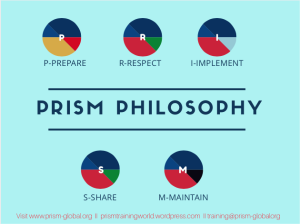RESPECT MODEL
- Prism Philosophy

- Feb 28, 2017
- 3 min read
THE RESPECT MODEL
Recognition
Recognition is a very powerful tool. People who are recognized for their efforts on the job feel respected, validated, and secure. They are more likely to engage, work harder, and feel better about what they do. Conversely, when their productive behaviors go unrecognized, people are less likely to repeat those behaviors.
Recognition does not come naturally to most people. Team members and leaders need to make recognition a priority by using simple tools like writing thank you notes, sending e-mail “shout outs,” or taking deserving individuals out for coffee.
Empowerment
When employees are empowered, they can think, behave, and act autonomously. They are able to maximize their potential as team members and their opportunities to succeed, which leads them to take initiative and achieve more success. Unfortunately, there are many forms of resistance to empowering people, including:
*Team leaders who fear that giving autonomy and authority to others diminishes their own importance.
*Team leaders who lack knowledge of how to empower others.
*An unwillingness to spend money on training that is necessary to help people succeed.
On a SuperTeam, strategic development plans are created for every member. Team leaders determine when and what type of training is needed, and seek appropriate new challenges for everyone. Relatively inexpensive ways to enhance the empowerment process include:
*Offering cross-training so team members can support and cover for each other.
*Auditing the team’s skills in order to address talent needs.
*Establishing clear decision-making boundaries.
*Learning not just what the team is doing, but why things are done a certain way.
Supportive Feedback
Supportive feedback involves sharing straightforward, constructive perceptions and advice to help people improve. It should be encouraging, specific, and actionable. On a SuperTeam, feedback is both given and received respectfully; the giver shows respect by caring about the recipient’s growth and development, while the recipient shows respect by being open to the feedback and appreciative of the giver’s effort. Moreover, SuperTeam members take the initiative to ask each other for feedback.

It is not easy to provide supportive feedback, but there are ten specific ways that SuperTeam members can improve how their feedback is structured and delivered:
When people give permission to a provider of feedback, they are less likely to react to the feedback defensively.
This approach is more effective than when a feedback provider simply pushes a point of view.
When people improve their behaviors, their attitudes change as well.
Assume the individual welcomes an opportunity to perform more successfully.
People who have experienced poor outcomes feel vulnerable and appreciate a feedback provider’s understanding.
This approach enhances the feedback recipient’s perception of fairness.
Feedback to a team member should be given in the spirit of collaboration.
Instead of making assumptions, the feedback provider should ask questions about what happened from the recipient’s point of view.
Feedback providers must recognize that theirs is a personal perspective, and that they should be open to the perspectives of others.
Feedback should be delivered in a straightforward way, not watered down or obfuscated.
Partnering
SuperTeams go beyond collaboration; they work together to partner in ongoing, committed relationships where each member has the others’ interests at heart. These partnerships may be short or long term, formed to accomplish specific tasks or to achieve visionary goals. They may include other teams both inside and outside of organizations.
Unfortunately, many partnerships fail to realize their true potential. Based on the authors’ research, failure can most effectively be avoided when teams pay attention to 12 key organizational and interpersonal factors:
The efforts of partners may be misaligned in the absence of a shared vision.
There should be partnership agreement on the principles that determine what is important to all members.
Culture is the underpinning of social mores and how things work in a partnership.
All members must clearly understand what they are counted on to do and what will be done by other members.
Teams often include people with different but complementary skills and abilities. To function as partnerships, team members need clarity about what talents are needed and how to obtain them.
In powerful partnerships, people are trained to be able to support and cover for each other.
Partners take responsibility for helping others learn the skills they need or shift roles to take advantage of their strengths.
In a partnership, people’s performance can be clearly evaluated based on criteria that everyone knows.
Partners are committed to the team for the long term and are willing to address any weakening of commitments that may occur.
Partners collaborate not only to accomplish specific tasks, but also to build relationships and support each other.
Personal integrity of all members is an indispensable element in effective partnerships.
Partners must have open lines of communication at all times, especially when there are relationship problems.






Comments